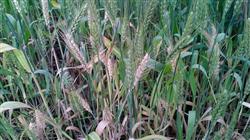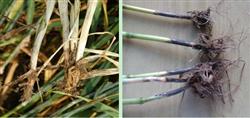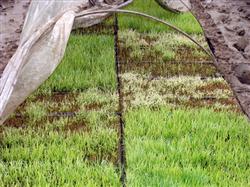Control of wheat sheath blight by early application of Thiofuroamide in spring

In recent years, the planting area of direct seeding rice in northern Jiangsu and other places is large, which leads to the late sowing time of wheat. In order to ensure the yield of late sowing wheat, the sowing rate is often greatly increased, the amount of seeds used in high fields is 20kg to 30kg per mu, the growth of wheat seedlings in the field is too dense, with the recovery of air temperature in spring, the growth of wheat resumes rapidly, and the canopy density in the field will further increase. It is beneficial to the occurrence of sheath blight. In November 2011, the rainfall in northern Jiangsu is sufficient, the field humidity is high, sheath blight has occurred in some fields, and there are obvious black spots in wheat leaf sheath. It is expected that the occurrence of wheat sheath blight after the temperature rise this year is more serious than that of last year. Chemical control in early spring is an important means to control wheat sheath blight. At present, Jinggangmycin, Jinggang Bacillus cereus, Jinggang Bacillus subtilis and other drugs are mostly used for prevention and control, but the duration of these drugs is short, and farmers often wait until after the disease to start using drugs, the effect is poor. Thiofuramide is a benzamide fungicide, registered for the control of rice sheath blight, has a high selectivity, has a good control effect on rust, smut, sheath blight and other diseases, and lasts for 30 to 45 days. In recent years, the author has carried out a study on the application of thiofuramide on wheat. The experimental data show that 24% thiofuramide suspension was used for 10 ml and 20 ml per mu on March 5 and March 15 before jointing, respectively. the control effects on sheath blight 30 days after treatment were 94.38%, 97.78% and 97.41%, respectively, and the white ear rate was 0. However, on April 5 and April 15 after jointing, the control effect of the same chemical treatment on wheat sheath blight decreased significantly. The results show that wheat is the best period to control sheath blight before jointing. The use of 24% thiofuramide suspension 10ml / mu can effectively control the occurrence of sheath blight, reduce white spike and increase yield.
- Prev

Prevention and treatment of Blackfoot Disease starts with seed dressing of Wheat
Wheat total erosion disease, also known as Blackfoot disease, is a devastating disease in wheat production. After the wheat was infected, the tillers decreased, the spike rate decreased, the 1000-grain weight decreased, the light ones reduced the yield by 10% to 20%, the heavy ones reduced the yield by more than 50%, or even no harvest. Wheat can be damaged during the whole growth period, but it is affected by seedling stage and seedling height of 15 cm.
- Next

Common knowledge of Rice Black-streaked Dwarf Disease in South China
Rotten rice seedlings are the general name of rotten seeds, rotten buds and dead seedlings that occur in the seedling stage. Rotten rice seedlings can be divided into two types: physiology and infectivity. Physiological rotten seedlings are mainly caused by low temperature and poor management measures, infectious rotten seedlings are caused by pathogen infection, and the main diseases are rice cotton rot, rice rot and rice.
Related
- The first cup of black tea in spring, the flavor and history of tea gardens in Kenya, Africa
- The computer can not only choose potatoes, but also grow tea rice. AI will grow winter oolong tea champion.
- It is not only the inflated tea bitten by insects, but also engraved with the four seasons tea in Beipu.
- The Oriental Beauty Tea Festival in Zhuxian County takes the stage at the weekend to experience the plus-size feast of oil tea.
- & quot; Oriental Beauty Tea & Exploration of Emei in Hsinchu, the hometown of quot;
- The new variety of strawberry "Tainong 1" dessert is the first choice with mellow aroma. Crimson gorgeous
- History of Tea in Taiwan: from Wild Inner Mountain to Export Tea Garden
- Two types of Taiwan Oriental Beauty Black Tea won the British three-Star Award for Childhood Tea Xiang Zhang Jiaqi changed from pilot to champion tea maker.
- Banana species and varieties: the planting history of Taiwan Xianren banana and dwarf banana is long, is banana disease resistant?
- Coffee planting Technology: Qianjie Coffee from Seedling to harvesting

